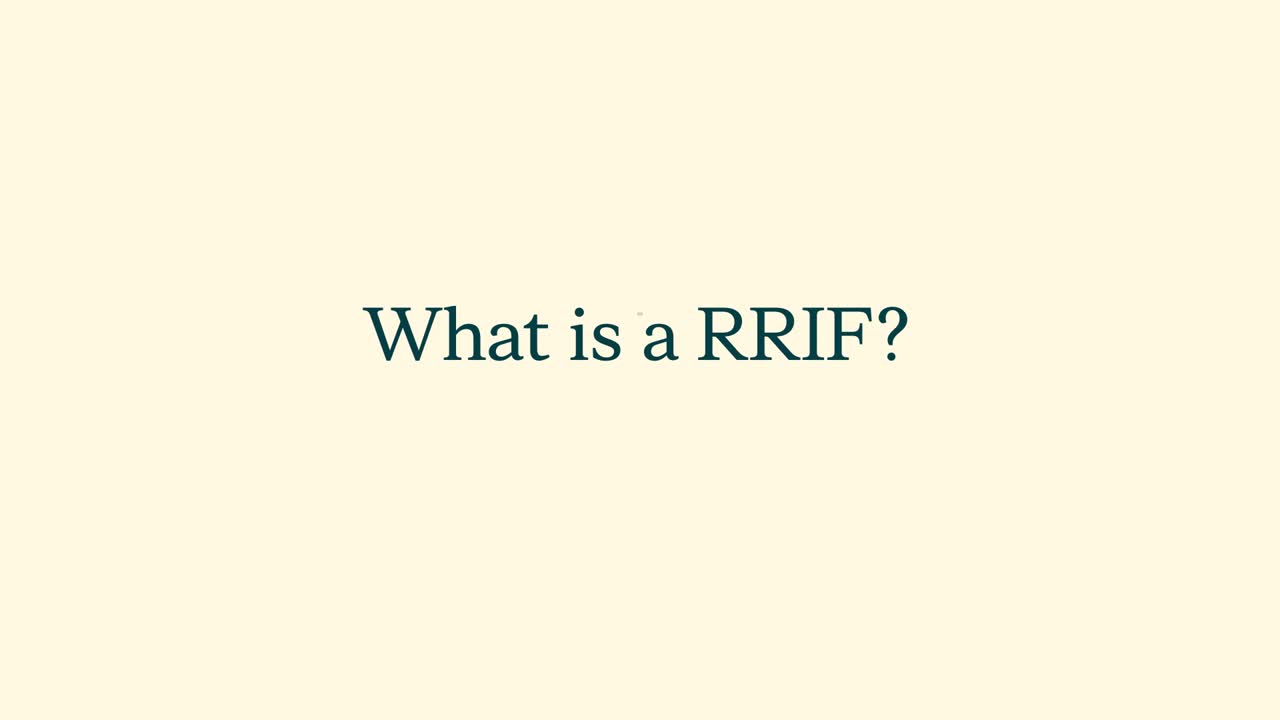Last updated : June 22, 2023 | Reviewed by Stuart Dollar

What is a RRIF?
A registered retirement income fund (RRIF) is an investment account that pays you income during retirement. You can transfer tax-sheltered funds from registered Canadian accounts such as RRSPs, registered pension plans and other RRIFs into a RRIF.
What is a RRIF?
Simply put, you can't keep your retirement savings in an RRSP forever. Many people move their savings to a Registered Retirement Income Fund, more commonly known as a RRIF.
What is a RRIF?
A RRIF is one of the ways you can convert an RRSP into an income stream. Then, this income can help support you in your retirement.
A RRIF keeps you in control of how you invest your money. You can choose to invest in:
- Guaranteed investment certificates
- Mutual funds
- Segregated fund contracts
- Other types of investments that align with your risk tolerance and your financial plan.
When do you have to take money out of an RRSP?
By the end of the year you turn 71, you have to decide what to do with your RRSP. But, you don’t necessarily need to withdraw all your savings at once and pay a large tax bill. One choice to consider is converting some or all of your RRSP into an income-producing RRIF. That way, your savings can continue to grow tax-deferred, until you withdraw funds.
How can a RRIF help boost your tax savings?
Tax deferral means you won’t have to pay tax on investments growing in an account until you take money out. The tax deferral you enjoyed with your RRSP continues with your RRIF.
How can you control your funds in retirement?
In many ways, a RRIF works like an RRSP in reverse. Instead of putting money in, you take income out.
You do have to make a minimum withdrawal every year. These withdrawals are subject to tax. There's no limit to how much you can withdraw. You can take as much as you want, when you want.
How can you leave money to your loved ones?
In most cases, you can name your spouse or common-law partner as a beneficiary. Then, your RRIF savings can go to their RRIF or RRSP when you die.
For more tips and tools, visit sunlife.ca.
How does a RRIF work?
You can open a RRIF at a financial institution, at any time. If you own RRSPs, you must convert your RRSPs to a RRIF or RRIFs before the end of the year you turn 71. When you do this, you’re directly transferring funds from your registered accounts to a RRIF. For example, you can transfer funds from these sources:
- your RRSP* or from another RRIF you own, (Learn how to convert your RRSP to a RRIF)
- your unlocked funds from a pension plan,
- your spouse or common-law partner’s RRSP or RRIF upon death, separation or divorce,
- your employer’s deferred profit-sharing plan (DPSP),
- your spouse or common-law partner’s employer’s DPSP upon death, separation or divorce.
*If your RRSP is with Sun Life, we’ll notify you before the end of the year you turn age 71. At that point, we may offer you various retirement income options.
You can begin taking withdrawals from your RRIF in the year you open it, although there’s no obligation to do so. However, there’s a minimum amount you’ll need to withdraw starting the year after you open your RRIF, and continuing for every year after that. You’re free to withdraw more than the minimum amount from your RRIF. But you can’t apply the extra you take out this year towards next year’s minimum. If you take out more than the minimum in any year, you’ll still have to take out the minimum amount next year. You can own more than one RRIF, and these rules will apply to each of your RRIFs.
RRIF contributions
You can make contributions to your RRIF only from your RRSP, other RRIFs you own, and certain other retirement plans.
If you’re under age 71, you can convert some or all of your RRIF funds to an RRSP. This may be helpful if you no longer need the RRIF income. Connect with an advisor to find out what’s best for your unique situation.
RRIF withdrawals
You’re required to make a minimum annual withdrawal from your RRIF, starting no later than the year after you’ve opened it.
You’ll be taxed on your withdrawals. Withdrawals greater than the minimum amount will be subject to withholding tax.
Open a RRIF
Ready to convert your savings into a RRIF? A Sun Life advisor can set you up. They can help you figure out which plans and products can benefit your unique situation.
Enter your postal code to find an advisor near you.
Already have a RRIF with Sun Life?
Sign in to my Sun Life to access your account.
Available self-serve features depend on your account, contract or policy.
Frequently Asked Questions
What happens to a RRIF when you die?
It depends on the situation. In many cases, a RRIF can roll over to the surviving spouse or common-law partner’s RRIF on a tax-deferred basis.1 Depending on their age, they may also roll over the RRIF to an RRSP. The surviving spouse or common-law partner won’t require additional RRSP contribution room when the rollover happens.
There are certain exceptions. For example, if you don’t have a spouse or common-law partner, or your beneficiary isn’t your spouse or common-law partner, the value of your RRIF is included as income in your final tax return.
1 If the deceased had not withdrawn the full minimum amount from their RRIF before death, the difference between what they were required to withdraw and what they did withdraw would be included in their final tax return. This amount can go to the surviving spouse or common-law partner, but can’t be deposited to their RRSP or RRIF.
What is a spousal RRIF?
When a spousal RRSP is converted to a RRIF, it’s called a spousal RRIF. Only the spouse who is the annuitant (the owner) of the spousal RRIF can make withdrawals. If the contributing spouse has made a contribution to the spousal RRSP within the last three calendar years, the spousal RRIF income will be attributed to them to the extent the amount withdrawn exceeds the minimum amount.
What's the difference between an RRSP and a RRIF?
The main difference is that you save for retirement with an RRSP and you take income for retirement from a RRIF. However, if you need money before retirement, you can also make withdrawals from your RRSP. But keep in mind that RRSP withdrawals will have taxes withheld at source, while RRIF minimum withdrawals will not face any withholding tax.
